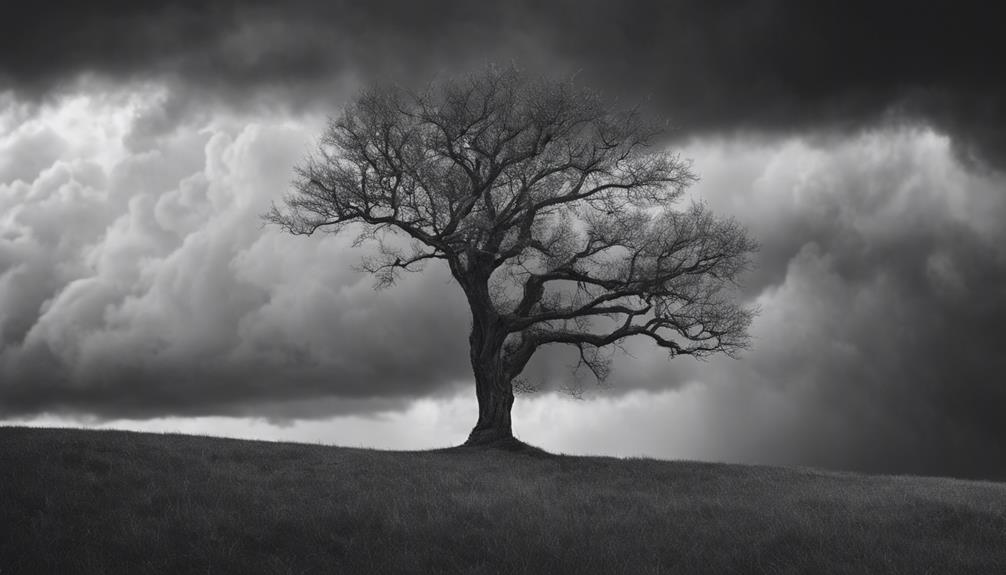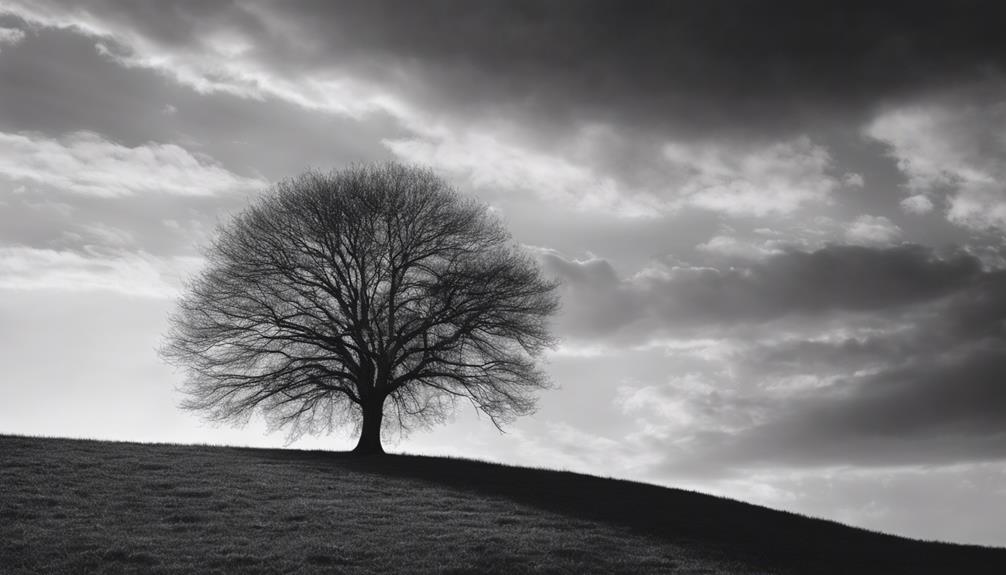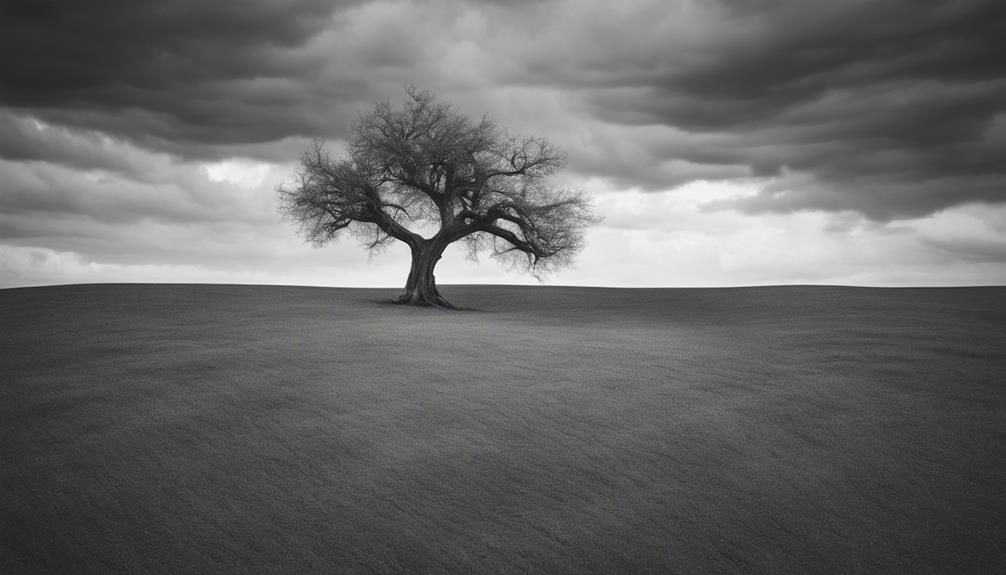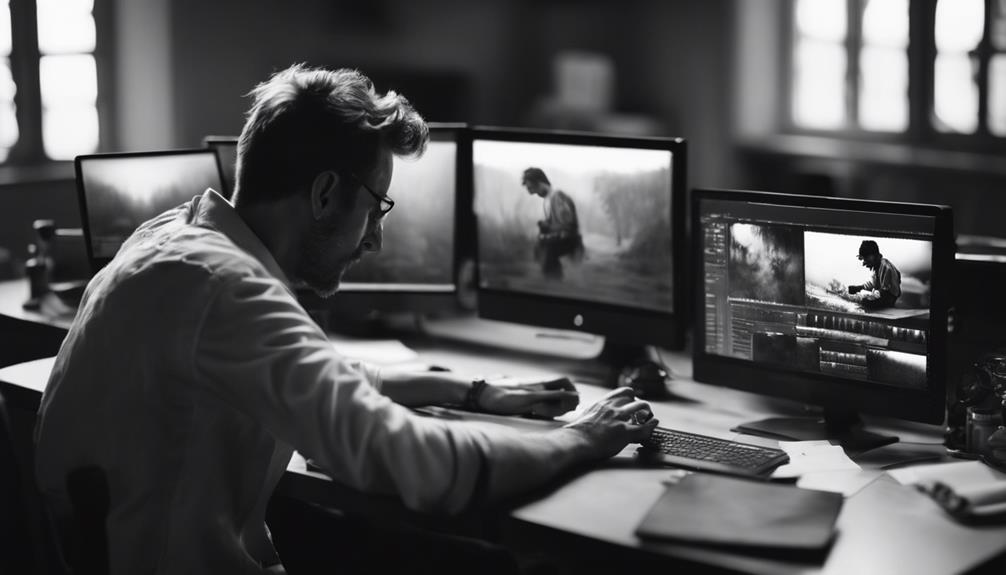To master black and white photography and bring out drama and emotion in your shots, you need to deeply understand the interplay of light, shadows, and textures. Start by focusing on subjects that naturally convey stories or emotions, visualizing how colors translate into greyscale. Experiment with light and contrast to enhance the emotional impact, manipulating shadows to create mood and mystery. Pay attention to textures, using sharp focus and balanced light to highlight details. Always aim for simplicity in composition, letting minimal elements convey complex emotions. Master these techniques, and you'll reveal layers of nuance in your images.
Understanding Black and White Basics

To truly grasp black and white photography, you must first understand its unique language of shadows, tones, and textures. Unlike color photography, where hues play the starring role, black and white images strip away this layer, challenging you to perceive the world through contrasts and gradients. Mastering this requires a deep appreciation of color theory, albeit in a different spectrum. You need to know how colors convert into shades of gray — blue might turn into a deep, almost black gray, while yellow could transform into a light, airy gray.
Choosing the right film is vital. Each black and white film has its own characteristics; some enhance contrast, sharpening the lines and deepening shadows, while others might offer a smoother gradient, softening textures and blending transitions gently. Your choice will dictate the mood and tone of your photographs. For instance, a high-contrast film can dramatize stormy skies or aging textures, whereas a low-contrast film might better suit subtle nuances of a foggy morning or a soft portrait.
You're not just capturing images; you're crafting visions with every click of your shutter. Let your understanding of these basics guide your creative decisions, turning ordinary scenes into enthralling tales of light and shadow.
Choosing the Right Subjects
Selecting the right subjects for your black and white photographs can transform a simple shot into a profound visual statement. Since color isn't a tool in your palette, you need to think about how color relevance and subject movement play into the visual impact of your images.
When considering color relevance, remember that colors convert into varying shades of gray. Bright yellows and deep blues won't appear the same in black and white. You'll need to visualize how the original colors will translate into gradients of gray, influencing the mood and depth of your photograph. For instance, a red flower might turn into a dark, almost black tone, offering a dramatic contrast against a lighter background.
Additionally, subject movement can dramatically affect the emotion conveyed in your composition. Static subjects can give a sense of calm and permanence, while capturing movement can inject a feeling of dynamism or tension. Think about how a flowing river, a bustling city crowd, or swaying trees can add a layer of narrative or emotion to your image.
Always aim to evoke a story or an emotion through your choice of subject. Whether it's the timeless tranquility of an old building or the ephemeral gesture of a dancer, your subject choices are essential in crafting compelling black and white photography.
Mastering Light and Shadows

Understanding how light and shadows interact is key to enhancing the dramatic effect of your black and white images. Mastering this dance can transform the mundane into the extraordinary. You'll need to start by honing your skills in light metering. This technique allows you to measure the light in the environment accurately, ensuring that your highlights and shadows are perfectly balanced. It's not just about capturing light; it's about capturing the right amount of light.
Shadow play, on the other hand, is where your creativity truly shines. Shadows aren't just absences of light; they're shapes, forms, and lines that tell as much of a story as the light itself. You can manipulate shadows to create mood, direct attention, and even add a sense of mystery to your compositions. Think of shadows as your canvas and light as your paint; together, they allow you to illustrate your artistic vision with striking contrasts and nuanced gradations.
Exploring Textures and Details
Exploring textures and details in black and white photography lets you uncover the subtle intricacies that bring depth and life to your images. Without the color distractions, you're compelled to focus more on the structural elements of your subject. The absence of color pushes you to enhance the focal sharpness, making every crack, crease, and crinkle stand out. This transformation isn't just about removing color; it's about seeing anew and capturing emotions through contrasts and textures.
Here are some key points to enhance your texture-focused black and white photos:
- Maximize Sharpness: Use a smaller aperture to keep more of your scene in sharp focus.
- Play with Light: Side lighting can dramatically emphasize the textures of any surface.
- Choose Your Subjects Wisely: Textured subjects like old trees, peeling paint, or woven fabrics can be particularly striking.
- Experiment with Angles: Shooting at different angles can reveal textures that aren't visible head-on.
- Consider the Weather: Overcast days can help avoid harsh shadows and highlight details.
Composing With Simplicity

In black and white photography, mastering the art of simplicity can transform ordinary scenes into striking visual statements. When you compose with simplicity, you're not just taking a photo; you're crafting a narrative with minimal elements. Focus on minimalist framing; it's about what you decide to leave out just as much as what you include. This method allows you to highlight the essence of your subject in a significant yet understated way.
Consider the role of negative space in your compositions. This isn't just empty space; it's an essential element that balances your image and enhances the subject. By increasing the amount of negative space, you draw more attention to the main subject, giving it more weight and significance. This space acts as a refreshing element, making your subject pop without competition from surrounding elements.
You'll find that simplicity in composition requires you to scrutinize every part of the scene. Ask yourself, does each element add to the story you're trying to tell? If not, it's probably best to leave it out. Remember, a simple composition isn't about capturing less, but rather about conveying more with less. Embrace this approach and watch your black and white photography evoke deeper emotions and intrigue.
Using Contrast Effectively
After mastering simplicity in your compositions, let's focus on how you can harness the power of contrast to elevate your black and white photography. Contrast isn't just about the difference between the lightest and darkest elements in your photos; it's a powerful tool that can dramatically affect mood and focus.
Understanding color theory is essential, even in black and white photography. Colors convert into varying shades of gray, and knowing this will help you predict which colors will stand out and which will blend in. Filter effects can also play a significant role. By using color filters, you can manipulate which aspects of your composition are emphasized, enhancing contrast before you even click the shutter.
Here are five key strategies to use contrast effectively in black and white photography:
- Utilize natural light variations to create dynamic ranges in your images.
- Apply color filters to control the light and dark areas, enhancing textures and details.
- Seek out scenes with inherent contrast, such as shadows cast during the golden hours.
- Experiment with exposure settings to exaggerate contrasts, making your subjects pop.
- Play with textures and patterns to add depth and interest without color.
Implement these techniques, and you'll see how contrast can add a new dimension to your black and white images, making them more expressive and impactful.
Editing Techniques for Impact

Once you've captured your images, editing them skillfully can greatly enhance their impact and convey your artistic vision. In the domain of black and white photography, even the subtlest adjustments can transform a good photo into a breathtaking piece of art.
Firstly, consider the use of color filters in your editing software. Although you're working in black and white, color filters affect the grayscale intensity of different colors in the original photo. For instance, a red filter can darken blues and greens while lightening red and orange hues, giving skies a dramatic, dark appearance and highlighting cloud formations. Experimenting with different filters can dramatically alter the mood and focus of your photographs.
Noise adjustment is another essential tool. While some purists prefer the grainy feel of high ISOs in black and white photography, you might find certain shots benefit from noise reduction. Smoothing out the noise can help in refining the details and textures, making the subject stand out more distinctly. Conversely, adding a bit of noise might enhance the rugged, timeless quality of a street scene or a landscape.
Frequently Asked Questions
How Does Black and White Photography Affect Viewer Emotions?
Black and white photography strips away the distraction of color, focusing your attention on light, shadow, and textures. This color absence amplifies the emotional intensity, making you feel the scene's drama or serenity more profoundly.
It's a powerful tool that can evoke nostalgia, highlight contrasts, and convey deep emotions in a way that color sometimes can't. You'll find that these images often carry a timeless quality, drawing stronger emotional responses from viewers.
Can Black and White Photography Enhance Abstract Compositions?
Absolutely, black and white photography can enhance abstract compositions. By stripping away color distractions, you're compelled to focus on the raw textures and forms that define the essence of the subject.
This shift not only sharpens your texture focus but also amplifies the emotional impact of the image. It's like peeling back layers to reveal the soul of your artwork, urging viewers to connect on a deeper, more instinctive level.
Are There Iconic Black and White Photographers to Study?
Absolutely, there are several iconic black and white photographers you should study. Figures like Ansel Adams and Henri Cartier-Bresson have profoundly shaped the craft, offering a rich study in historical influence and technique evolution.
What Are Common Pitfalls When Starting Black and White Photography?
When you start black and white photography, common pitfalls include ignoring lighting and overprocessing images. Lighting isn't just essential; it plays a vital role in shaping the mood and depth of your photos.
Avoid the temptation to excessively edit your pictures as it can lead to unnatural results and distract from the natural beauty and emotion you're aiming to capture.
Instead, focus on mastering light to enhance the dramatic impact of your black and white photography.
How Does Film Choice Impact Black and White Photography Quality?
Imagine shadows deepening into velvety blacks and highlights gently kissing the edges of clouds. Your choice of film profoundly shapes these visuals.
Film sensitivity affects grain and contrast, important for mood and texture. The development process further influences the final image's sharpness and tonal range.
Mastering these elements allows you to elevate your black and white photos from mere snapshots to stirring, evocative art that resonates with emotional depth.
Conclusion
As you embrace the basics of black and white photography, remember: choose subjects that speak, master the play of light and shadow, and explore every texture and detail.
Compose with simplicity, yet use contrast to make your images sing. Finally, refine with editing to maximize impact.
Through this journey, you'll not only capture images; you'll craft stories steeped in drama and emotion, turning ordinary scenes into extraordinary symphonies of grayscale.
Keep shooting, keep exploring—your masterpiece awaits.
